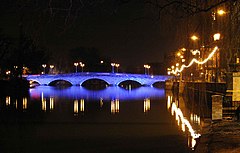Bedford bus station
| Bedford | |
|---|---|
 Bedford Town Bridge at night |
|
| Bedford shown within Bedfordshire | |
| Population | 87,590 |
| OS grid reference | TL055495 |
| • London | 57.4m |
| Unitary authority | |
| Ceremonial county | |
| Region | |
| Country | England |
| Sovereign state | United Kingdom |
| Post town | BEDFORD |
| Postcode district | MK40, MK41, MK42 |
| Dialling code | 01234 |
| Police | Bedfordshire |
| Fire | Bedfordshire and Luton |
| Ambulance | East of England |
| EU Parliament | East of England |
| UK Parliament | |
Bedford is the county town of Bedfordshire, England. The town has a population of around 80,000, whereas the Borough of Bedford had a population of 166,252 in 2015 together with Kempston.
Bedford was founded at a ford on the River Great Ouse, and is thought to have been the burial place of Offa of Mercia. Bedford Castle was built by Henry I, although it was destroyed in 1224. Bedford was granted borough status in 1165 and has been represented in Parliament since 1265. It is well known for its large population of Italian descent.
Bedford is on the Midland Main Line, with stopping services to London and Brighton operated by Thameslink, and express services to London and the East Midlands operated by East Midlands Trains.
The name of the town is thought to derive from the name of a Saxon chief called Beda, and a ford crossing the River Great Ouse. Bedford was a market town for the surrounding agricultural region from the early Middle Ages The Anglo-Saxon King Offa of Mercia was buried in the town in 796; this is believed to be in his new minster, now the Church of St Paul, or on the banks of the Great Ouse where his tomb was soon lost to the river. In 886 it became a boundary town separating Wessex and Danelaw. It was the seat of the Barony of Bedford. In 919 Edward the Elder built the town's first known fortress, on the south side of the River Great Ouse and there received the area's submission. This fortress was destroyed by the Danes. William II gave the barony of Bedford to Paine de Beauchamp who built a new, strong castle.
...
Wikipedia

